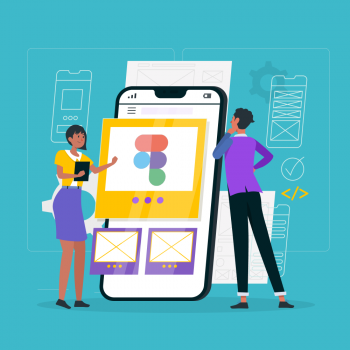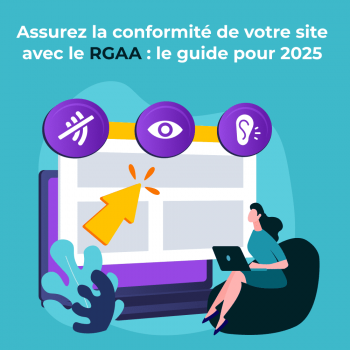Figma is an online design software that allows teams to design, prototype and animate user interfaces. As a SaaS solution, it is accessible via a web browser and does not need to be downloaded to your computer. Figma therefore ensures real-time collaboration between team members. It allows you to leave comments and suggestions directly on designs, track changes to the project, and easily share designs with others. It is compatible with different operating systems and devices, it is a multi-platform tool.
Why use Figma? Benefits and advantages of the solution
Figma is the benchmark for online collaborative design tools. It offers a wide range of features to facilitate the design process, such as the ability to create font and color styles, reusable component templates, advanced layout options, prototyping and animation tools, and much more. It is often used by design teams, developers, producers and marketers to create user interfaces, marketing designs and user experience designs.
There are several advantages and benefits to using Figma for your design projects:
- Real-time collaboration
Figma allows team members to work on a project at the same time, without overwriting each other's versions. Changes are applied in real time to make everyone's work more fluid. Figma also allows you to track changes made to the project.
- Multi-platform access
Figma is accessible via a web browser, so it is compatible with different operating systems (Windows, Mac, Linux) and devices (desktops, laptops, tablets, smartphones), which allows team members to work from anywhere, as long as they have access to the internet.
This greatly facilitates collaboration and communication between UX/UI design teams, project managers, developers and clients. Continuing on, Figma also offers greater flexibility for team members working remotely or on the road.
- Prototyping and animation tools
Figma offers prototyping and animation tools to create interactive and animated models of your designs. These tools allow you to simulate user interactions such as clicks, drag and drop, transitions, animations, forms, etc. This allows you to test designs before putting them into production and get a feel for how the end user will interact with the interface.
- Reusable component design
Figma allows you to create reusable components that can be used in other designs, saving time and effort. This means that when you create a design element, such as a button, form or menu, you can save it as a reusable component. You can then reuse it in other designs in the future, without having to recreate it.
Reusable components can be modified globally, maintaining visual consistency across all designs. The graphic charter is saved and errors and time-consuming work on repetitive details are greatly reduced.
- Easy sharing
Figma allows you to easily share designs with other people. It also allows you to give read or edit access to people outside the team. This means you can easily share designs with clients, partners or members of other teams.
Designs can be shared using unique, password-protected links, which allows you to control who has access to the designs and what features they have access to.
- Comments and feedback
Figma allows comments and suggestions to be left directly on the designs, facilitating communication and coordination between team members. Comments and suggestions are left directly on the designs, making feedback and comments much easier. It is also possible to mention team members in the comments, who receive a notification. Comments can also be resolved or closed to track progress and improvements to designs.
- Third-party tool integration
Figma can be integrated with other tools such as Slack, Trello, Jira, etc. for better project management. You can connect Figma to other tools for better coordination, communication between teams and more effective collaboration.
For example, you can connect Figma to Trello to create automatic task cards from comments left on designs. or to Slack to receive notifications on design updates. Integrations also allow you to link designs to bug tickets in Jira, sync designs with content management tools and more.
- Flexibility
Figma is a very flexible tool. As such, it can be used to create designs for different types of projects such as user interfaces for web and mobile applications, marketing designs such as banner ads and landing pages and visuals for social networks. It also offers tools for creating interactive mockups, animations and prototypes.
Comparison of Figma alternatives and competitors
There are many design tools on the market that can be compared to Figma, such as:
- Adobe XD
Adobe XD is a user interface design tool developed by Adobe, similar to Figma in terms of prototyping and real-time collaboration features. It allows users to create interactive mockups, animations and wireframes, as well as easily share these designs with other team members. Adobe XD is only available on Windows and Mac operating systems.
- Sketch
Sketch is a vector-based design program designed for user interface design, logos, illustrations and other graphic projects, used primarily on the Mac. It is particularly useful for tasks involving the creation of vector shapes and editing of vector images, making it a popular choice for designers and product developers. It can be used for a variety of purposes such as creating mockups for mobile applications and websites, wireframes, logo design, icons and illustrations.
- InVision
InVision is a UI design tool that offers advanced prototyping features, such as animations, transitions and interactions, that allow you to create interactive and animated mockups of your designs. It also has collaboration features, such as comments and annotations, that allow team members to work together on a project.
However, InVision is not an online tool and requires a download and installation on the computer to use.
- Canva
Canva is an online graphic design platform for non-professional users looking to create graphics, presentations, and designs for various needs. It is easy to use and offers a wide selection of pre-designed templates and themes, as well as numerous graphic elements such as images, shapes, icons and fonts.
This makes Canva perfect for people who want to create designs for uses such as social networks, blogs, business cards, flyers, invitations, presentations, infographics, etc., without the need for graphic design skills.
- Miro
Miro is an online collaboration tool that allows people to visualize, plan, and work on projects as a team using charts, mind maps, diagrams, and other drawing tools to centralize their ideas, plans, and work in one place for better collaboration and more efficient project management.
Miro is therefore suitable for project planning, task management, workflow implementation, data visualization and real-time collaboration with distributed teams. It can be used in various fields such as technology, product development, project management, marketing, business strategy, etc.
- Adobe Illustrator and Adobe Photoshop
Adobe Illustrator is a professional vector design tool and Adobe Photoshop is a professional image editing tool, both developed by Adobe. Both tools are used to create illustrations, graphic designs and mock-ups. Both of these tools are more complex than Figma and lack the real-time prototyping and collaboration features.
It is important to note that each tool has its own advantages and disadvantages and it is important to choose the one that best suits your specific project needs.
Figma, the reference for mockup creation
In summary, Figma is a popular tool for designing user interface mockups and prototypes. This tool is accessible via a web browser, allowing real-time collaboration between team members and cross-platform access. It offers a wide range of features to facilitate the design process and is often used by design teams, developers, content producers, and marketers to create user interfaces, marketing designs, and user experience designs.
At Ylly, Figma is our primary mockup tool because of its ease of use, versatility, and ability to allow for seamless collaboration between team members, both internally and with clients.
To learn more about Figma, please contact us!








